WITH NATURE
BRIDGET BASKERVILLE
MEGAN COPE
WENDY DAWES
MARLEY DAWSON
SAMMY HAWKER
ANNIKA ROMEYN
CURATED BY ALEXANDER BOYNES
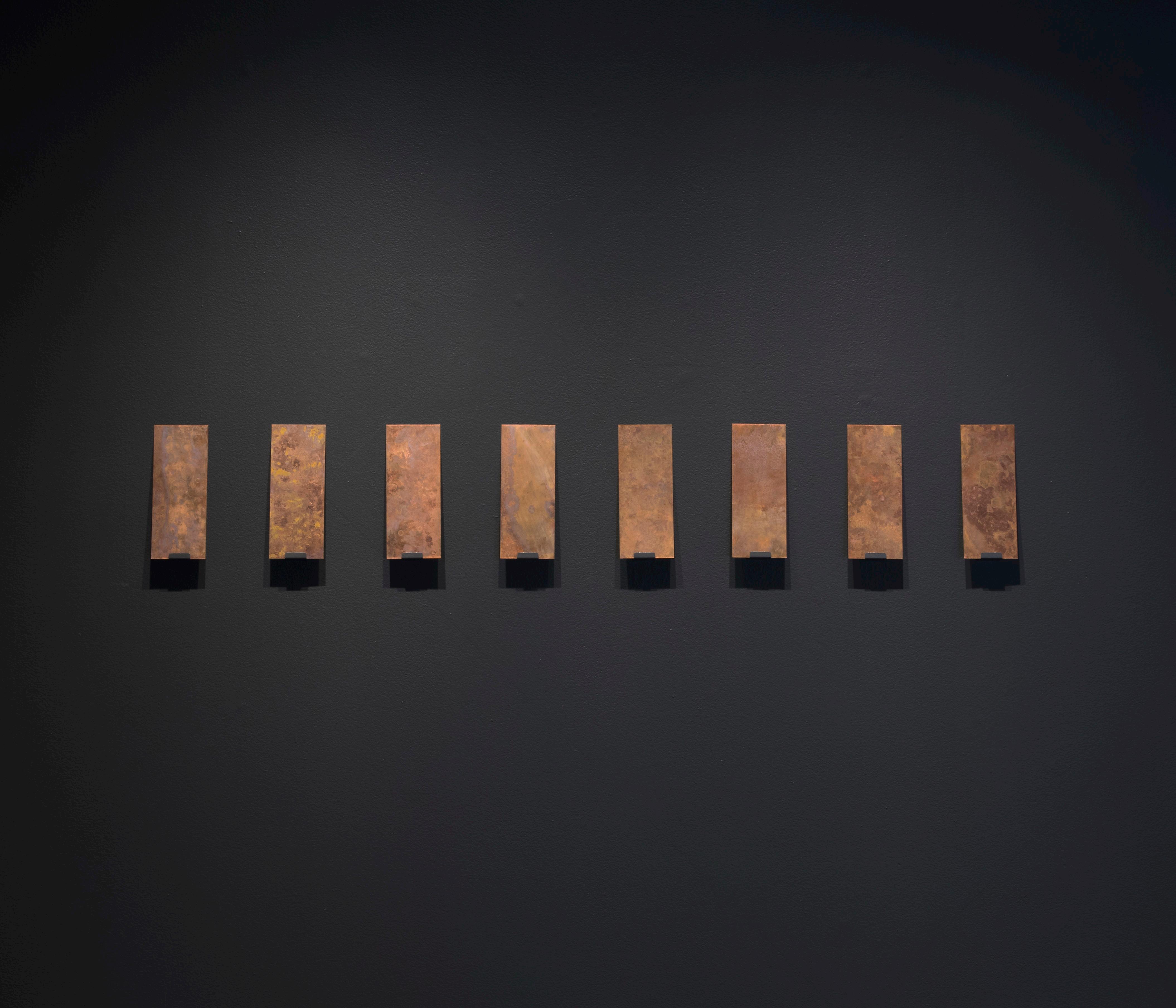 Image BRIDGET BASKERVILLE
Dead River (detail), 2023, Corroded copper plates (10 x 25cm each)
Photograph by Brenton McGeachie
Image BRIDGET BASKERVILLE
Dead River (detail), 2023, Corroded copper plates (10 x 25cm each)
Photograph by Brenton McGeachie
In the era of the Anthropocene, where human activities are profoundly impacting the planet’s well-being, addressing these effects has reached a critical standstill. Governments and corporations remain largely indifferent, leaving the pivotal issues of our time unaddressed, relying instead on the creative endeavours of artists and researchers to spur action. Yet, amidst this inertia, we face a daunting question: how do we proceed when the pursuit of global mobility and the desire to explore our planet appears increasingly more self-serving? Moreover, how do artists addressing these issues align the materials they employ in their studios with the messages they aim to convey as creators?
With Nature showcases work by six contemporary Australian artists who have collaborated with the environment, allowing the landscape to shape their work and reflect Earth’s transformations influenced by human activity. Recognising climate change as a cultural issue, these artists go beyond scientific data to convey its significance. Art, in my view, plays a crucial role in inspiring positive change amid this global crisis, offering hope for the future. The pandemic highlighted the power of human collaboration during challenging times, yet the profound levels of collaboration observed in nature present valuable lessons for reflection. Through various mediums such as photography, drawing, sculpture, and installation, the exhibition prompts us to consider: How can we engage with our natural environment to gain insights into building a sustainable future?
Bridget Baskerville, an emerging artist, divides her time between Kamberri/Canberra and her hometown of Kandos, located on Dabee Wiradjuri Country in NSW. She completed her Bachelor of Visual Arts (Honours) at the Australian National University School of Art & Design (ANU SoA&D) in 2022 and was artist-inresidence at Canberra Contemporary Art Space last year. Baskerville’s artistic exploration focuses on the multifaceted impacts of extractive industries on regional communities, encompassing social, ecological, economic, and health dimensions. Central to Baskerville’s practice is her examination of the interplay between extractive industries and water, with a strong emphasis on site-specific creation. Her piece Dead River (2023) originated from her 2023 residency in Queenstown, on the remote West Coast of Lutruwita/Tasmania, and comprises a two-channel video work alongside corroded copper plates. During her residency at The Unconformity, Baskerville extensively engaged with the Queen River, which is recognised as one of Australia’s most polluted waterways, often termed a ‘dead river’ due to its corrosive, lifeless waters, tinted bright orange by acid mine drainage from the Mount Lyell Copper mine. Immersing copper plates into the river and surrounding sediment, Baskerville facilitated their corrosion, symbolically referencing the extracted materials, particularly copper, intertwined with Queenstown’s mining history. The collaborative process with the water itself underscores the agency of water in the artist’s practice, further emphasised by the incorporation of the flowing sounds of the Queen River in Baskerville’s dualscreen video installation. Notably, a local resident remarked on the paradox where the river’s forceful flow actually masks its dead status, highlighting the profound disconnect between perception and reality.
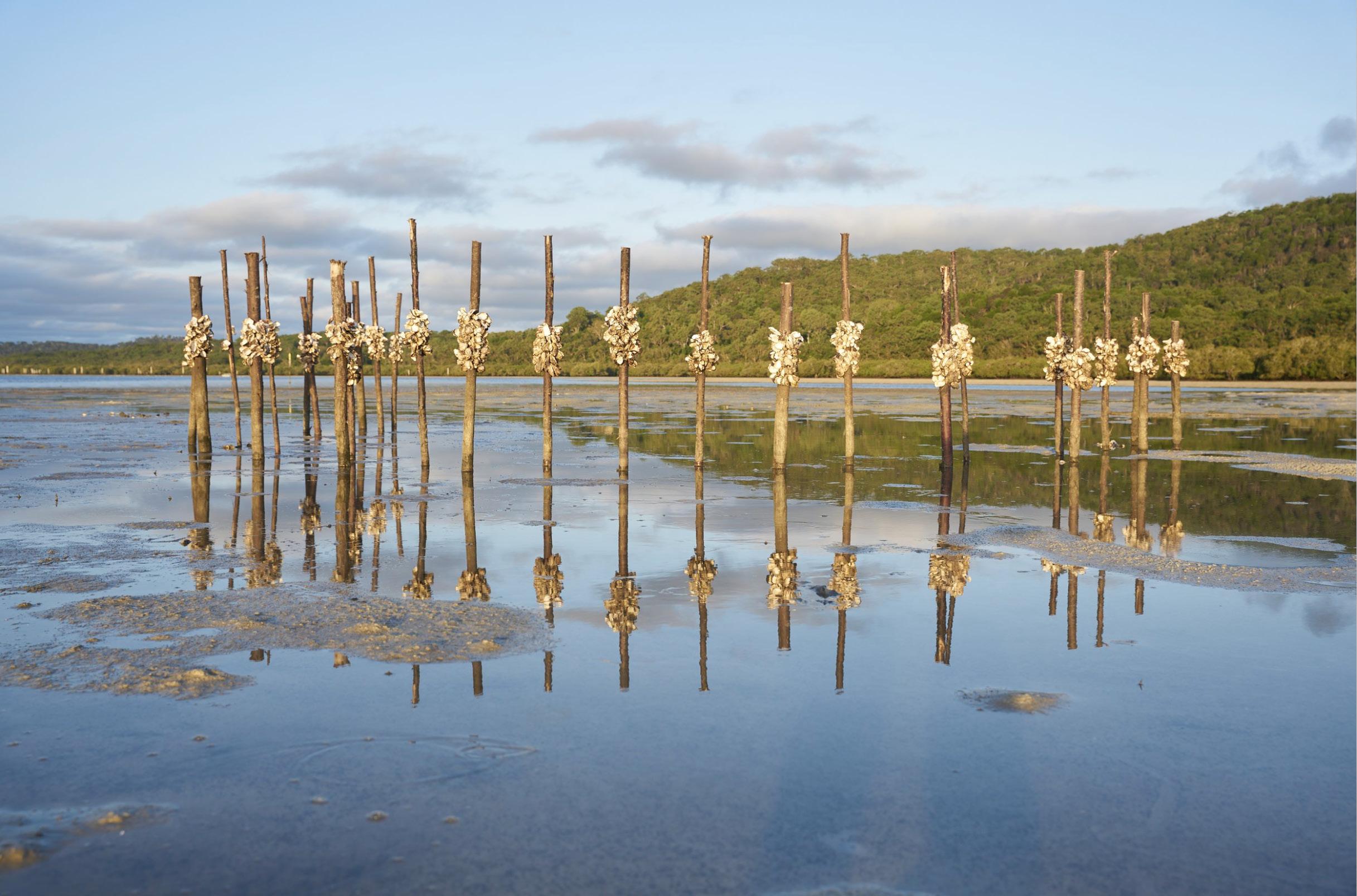 Image MEGAN COPE
Kinyingarra Guwinyanba (On Country) (video still), 2022
Single channel video, 6:36 duration
Videography by Cian Saunders
Image MEGAN COPE
Kinyingarra Guwinyanba (On Country) (video still), 2022
Single channel video, 6:36 duration
Videography by Cian Saunders
Megan Cope, a Quandamooka artist from Minjerribah/North Stradbroke Island in Southeast Queensland, is known for her site-specific sculptural installations, public art, and paintings. Represented by Milani Gallery, Cope’s work frequently challenges conventional ideas of Aboriginality, and explores themes of colonial histories, the environment, and mapping practices. One of Cope’s works in With Nature is the video documentation of Kinyingarra Guwinyanba (2022), a hand-built sculptural project in the waters of Minjerribah resting near Myora on the intertidal zone. After years of research into the impact of colonial industries on Quandamooka Sea Country, Kinyingarra Guwinyanba (meaning ‘place of oyster rocks’ in Jandai & Gowar language), returned to Country as a sea garden which supports new life, illustrating how art can heal colonised land through ecologically restorative and ancestral practices. Also featured in the exhibition is Untitled (Extractions II) (2020), a series of fragmented pillars and structural forms exploring the reinterpretation of industrial materials like concrete. The work references Australia’s lime burning industry, and its adverse effects on Aboriginal shell middens and oyster reefs in Quandamooka Country and coastal regions nationwide. These pillars serve as a metaphor for the enduring legacy of colonisation.
Wendy Dawes, a Kamberri/Canberra-based artist and recent ANU SoA&D graduate, employs printmedia, drawing, and animation to explore the vulnerability of individual and collective memory. Her works pair repurposed materials from her upbringing with contemporary technologies, and address global concerns using personal narratives, weaving together elements of the past and present as a means to comprehend the future. Dawes’ artwork Perpetual Motion Machine (2024) integrates elements of nostalgic classroom technology harking back to the 1970s and 80s, offering a contemplative exploration of a bygone era when environmental education in schools often boiled down to simplistic messages such as ‘CFCs are bad.’ Here, Dawes skilfully juxtaposes the sentimental visual language evoked by an overhead projector with a deconstructed LCD screen, upon which hand-drawn rotoscope animations of renewable power sources are displayed. The artwork serves as a poignant reflection on the disparity between environmental awareness and global health education during the artist’s formative years, underscoring the subsequent widespread disregard and indifference towards scientific advancements on a global scale. Notably, the inclusion of a meter to monitor both daily and overall power consumption throughout the exhibition acts as a candid acknowledgment of the artist’s own contribution to resource consumption, while also shedding light on the ongoing challenges posed by the inadequacy of renewable energy sources in meeting our ever-growing daily power needs.

Known for his innovative sculptures and installations, Marley Dawson explores the uncanny and surreal aspects of our world through a fusion of chemistry, mechanics, and construction techniques. Operating between Kamberri/Canberra and regional Victoria, Dawson’s practice is marked by a dynamic and playful approach that captivates viewers. Represented by Roslyn Oxley9 Gallery, Dawson has exhibited extensively both domestically and internationally. With Nature features two of Dawson’s kinetic works, Hum (Louis + Morris) (2022) and Untitled (tumbleweed again) (2013), both of which embody his fascination with DIY processes and the overlooked elements of daily life. Untitled (tumbleweed again) features an irradiated tumbleweed from New Mexico, delicately tracing an undulating arc around a central motor, evoking a sense of humour, surrealism, and melancholy. Meanwhile, at the other end of the gallery, Hum (Louis + Morris) comprises rectangular structures housing brass rods that sway like reeds in the wind, creating a shimmering illusion reminiscent of sunlight filtering through tall grass. Dawson’s works encourage viewers to reconsider their perceptions of the world, prompting contemplation of the extraordinary within the mundane. Through the amalgamation of art and science, Dawson’s continuous exploration of materials and processes underscores his dedication to pushing artistic boundaries and encouraging dialogue about the wonders of our environment and selves.
Kamberri/Canberra-based artist Sammy Hawker explores the interplay between material and immaterial aspects of sites, spaces, and the body through experimental photography. Collaborating with oceans, bees, eucalyptus trees, and human ashes, she integrates these elements into her practice to co-create imagery that reflects the essence of the subjects she works with. The works featured in With Nature offer a unique perspective on place, and what distinguishes them is the unconventional method of development. Hawker’s process involves developing analogue film on-site using water from the location, incorporating collected rain or saltwater to corrode the silver emulsion and imbue the images with the site’s essence, fostering a dynamic dialogue between the photographer and the environment. Hawker’s experimental technique challenges traditional approaches to film development and cultivates a deeper connection between art and nature. She embraces the collaborative nature of her process, allowing the environment to shape the outcome.
Image MARLEY DAWSON
Hum (Louis + Morris), 2022
Brass, steel, timber, electronics, 184 x 71 x 6cm each
Photograph by Brenton McGeachie
 Image ANNIKA ROMEYN
Wana Karnu, 2024
Rust and ink on Rives BFK 300gsm paper, 240 x 360cm
Photo by Brenton McGeachie
Image ANNIKA ROMEYN
Wana Karnu, 2024
Rust and ink on Rives BFK 300gsm paper, 240 x 360cm
Photo by Brenton McGeachie
Annika Romeyn, a Kamberri/Canberra based artist and ANU SoA&D graduate, takes her inspiration from the natural environment in Australia, and combines watercolour, drawing and printmaking processes to create intricate and immersive works on paper. Romeyn is represented by Flinders Lane Gallery, Melbourne, and in 2023 she was recipient of the Mandy Martin Art and Environment Award. Her contributions to With Nature stem from her connection to the Mutawintji National Park in NSW. Following her initial visit in 2022 for the Broken Hill City Art Gallery’s Open Cut Commission, she returned in 2023, immersing herself in the landscape and learning from Wiimpatja, the Traditional Owners and Custodians of land. Her piece Wana Karnu (2024) is a multi-panel rust and ink drawing which seeks to capture the heightened experience of walking the gravelly ridges at sunset, reflecting the rich colours of iron oxide and ‘rock rust’ formed by the interaction of iron, oxygen, and water. To create the works Romeyn placed damp paper on top of mild steel plates, covered it with plastic and weights, and left them for hours, often overnight. This process allowed chemical reactions to generate corrosive effects on the paper’s surface, introducing a limited colour palette to evoke the emotive nature of the landscape. This exploration of rust as a medium signifies a new phase in Romeyn’s artistic process.
With Nature invites us to engage with the environment in fresh and inventive ways. Together, these six artists demonstrate art’s ability to prompt introspection, foster conversation, and inspire action in addressing environmental challenges. The exhibition strives to underscore the significance of creativity, collaboration, and environmental stewardship in forging a sustainable future for all.
Alexander Boynes
Curator, Program Manager
Canberra Contemporary Art Space
 Left to Right SAMMY HAWKER
Salt Marks II, 2021-2023
Pigment ink-jet print, 60 x 84 cm, edition 1 of 10 +AP
Dark Crystals, 2021
Pigment ink-jet print, 110 x 138 cm, edition 2 of 5 + 2AP Wana Karnu, 2024
Photo by Brenton McGeachie
Left to Right SAMMY HAWKER
Salt Marks II, 2021-2023
Pigment ink-jet print, 60 x 84 cm, edition 1 of 10 +AP
Dark Crystals, 2021
Pigment ink-jet print, 110 x 138 cm, edition 2 of 5 + 2AP Wana Karnu, 2024
Photo by Brenton McGeachie
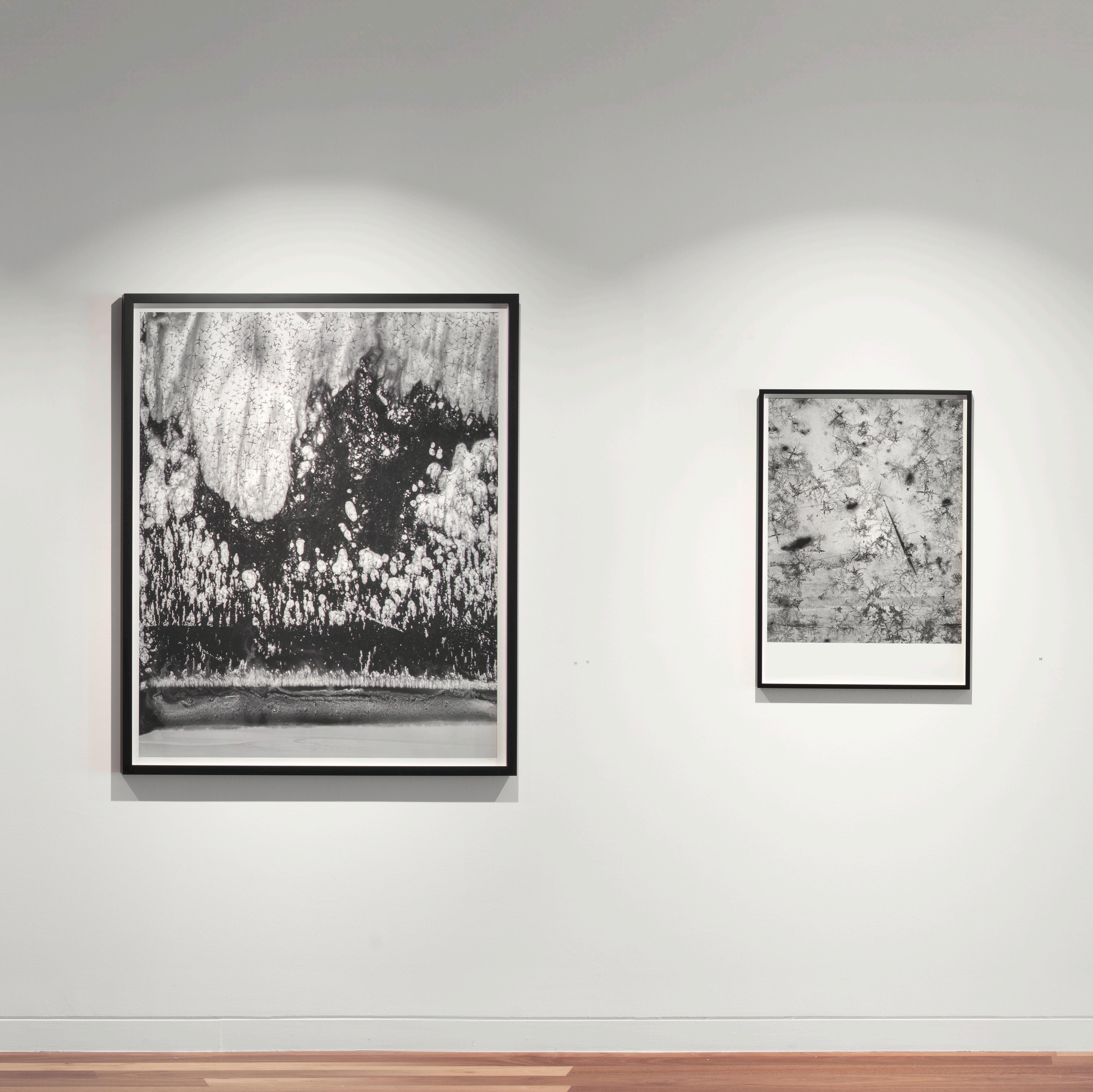 Left to Right SAMMY HAWKER
Mount Gulaga, 2021
Pigment ink-jet print, 110 x 138 cm, edition 3 of 5 + 2AP
Salt Marks I, 2021-2023
Pigment ink-jet print, 60 x 84 cm, edition 1 of 10 +AP
Photo by Brenton McGeachie
Left to Right SAMMY HAWKER
Mount Gulaga, 2021
Pigment ink-jet print, 110 x 138 cm, edition 3 of 5 + 2AP
Salt Marks I, 2021-2023
Pigment ink-jet print, 60 x 84 cm, edition 1 of 10 +AP
Photo by Brenton McGeachie
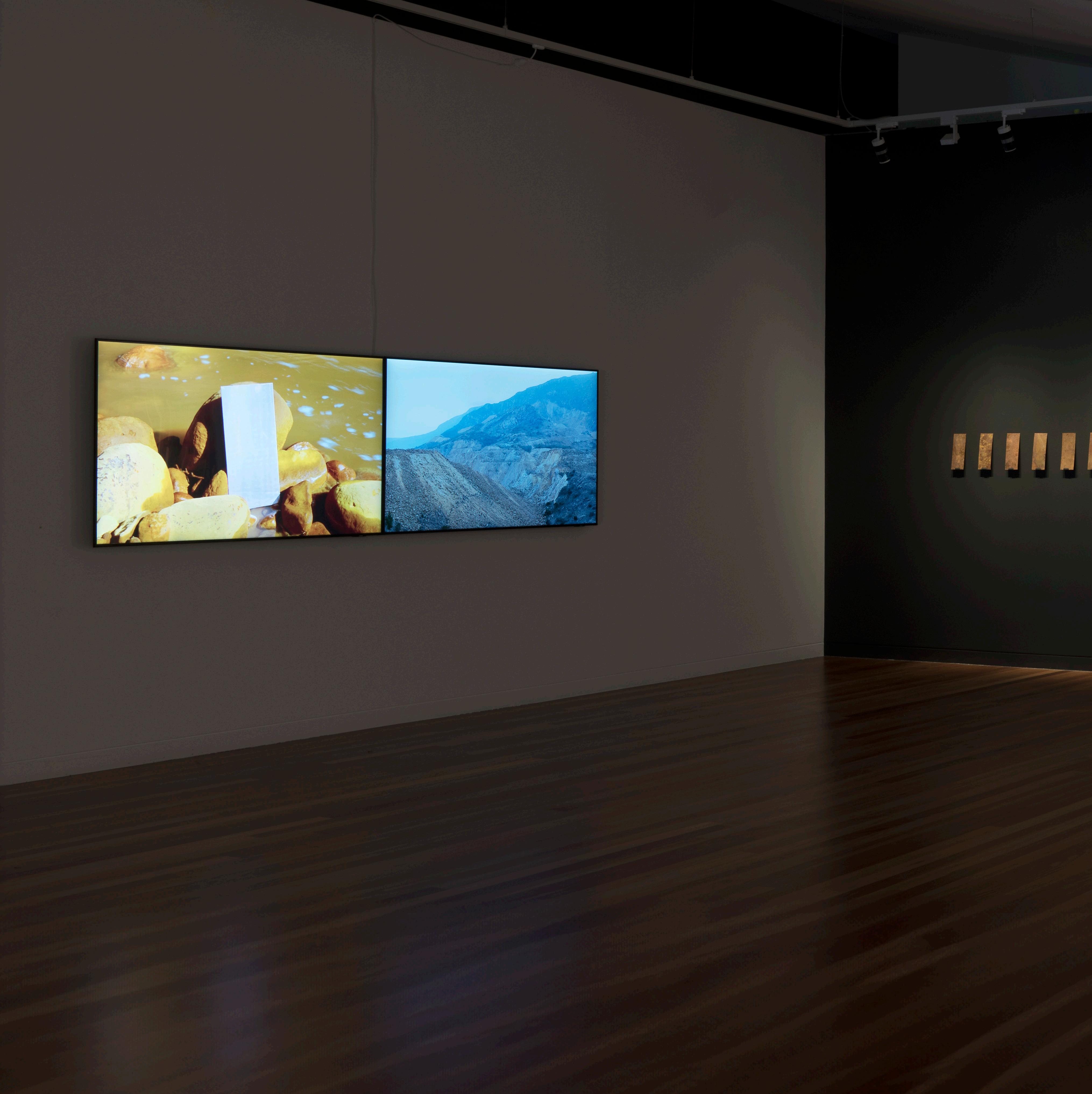 Left BRIDGET BASKERVILLE
Dead River, 2023
Corroded copper plates (10 x 25cm each), 2 channel video, dimensions variable
Photograph by Brenton McGeachie
Left BRIDGET BASKERVILLE
Dead River, 2023
Corroded copper plates (10 x 25cm each), 2 channel video, dimensions variable
Photograph by Brenton McGeachie
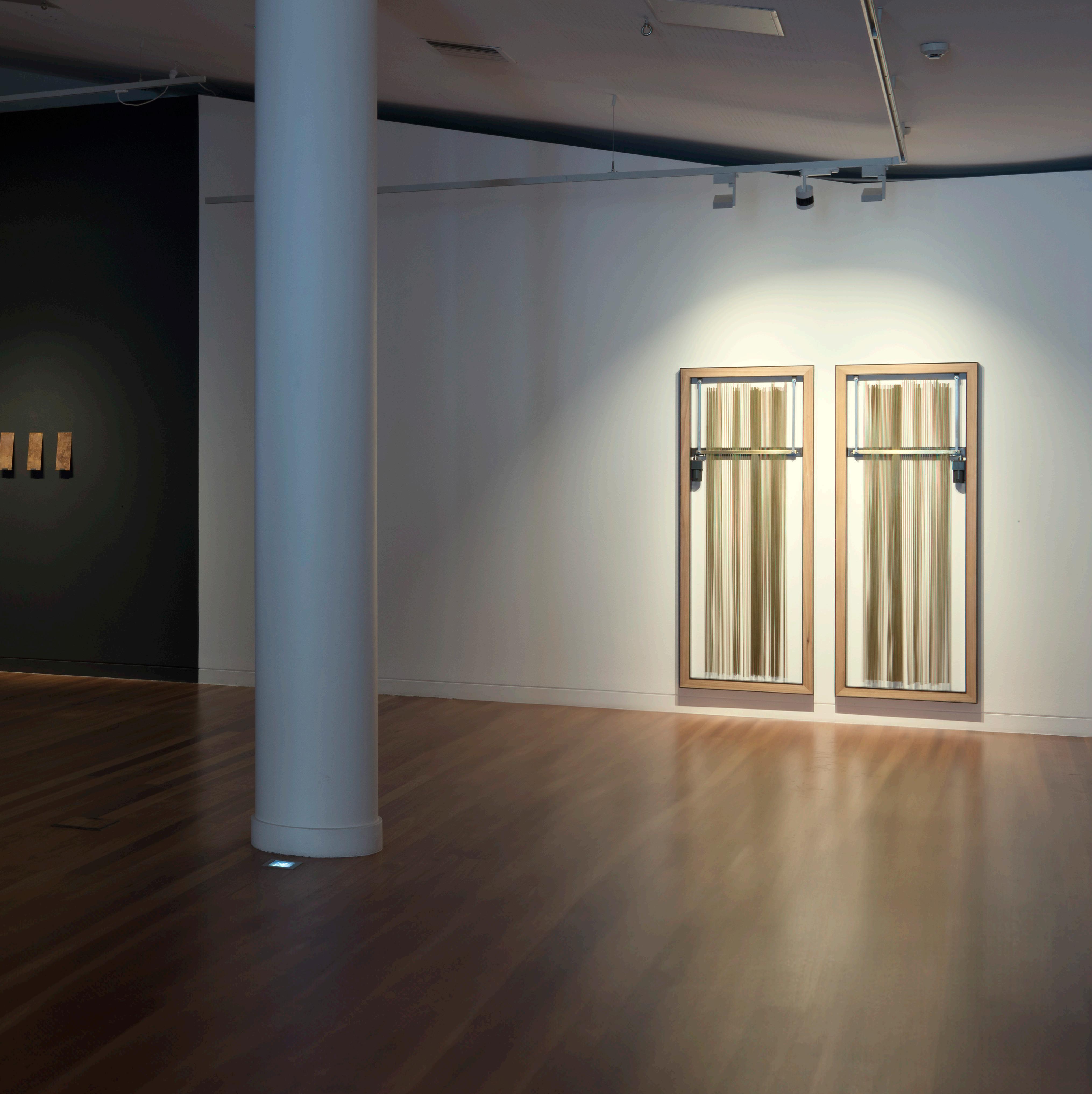 Right MARLEY DAWSON
Hum (Louis + Morris), 2022
Brass, steel, timber, electronics, 184 x 71 x 6cm each
Photograph by Brenton McGeachie
Right MARLEY DAWSON
Hum (Louis + Morris), 2022
Brass, steel, timber, electronics, 184 x 71 x 6cm each
Photograph by Brenton McGeachie
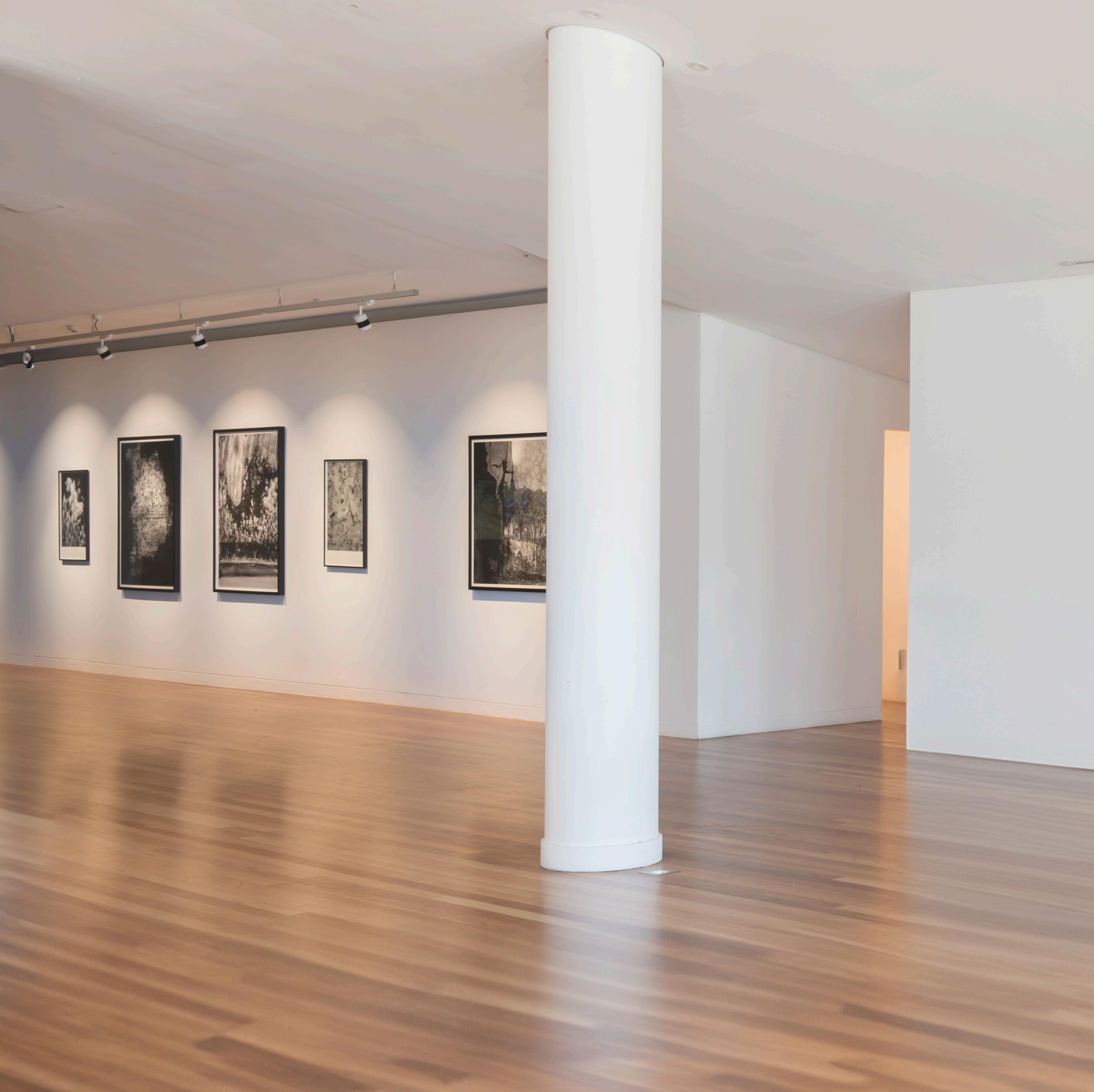 Left SAMMY HAWKER
Photo by Brenton McGeachie
Left SAMMY HAWKER
Photo by Brenton McGeachie
 Above MEGAN COPE
Kinyingarra Guwinyanba (On Country), 2022
Single channel video, 6:36 duration, videography by Cian Saunders
Right MEGAN COPE
Untitled (Extractions II), 2020
Concrete, pacific oyster shells, abalone shell, dimensions variable
Photo by Brenton McGeachie
Above MEGAN COPE
Kinyingarra Guwinyanba (On Country), 2022
Single channel video, 6:36 duration, videography by Cian Saunders
Right MEGAN COPE
Untitled (Extractions II), 2020
Concrete, pacific oyster shells, abalone shell, dimensions variable
Photo by Brenton McGeachie
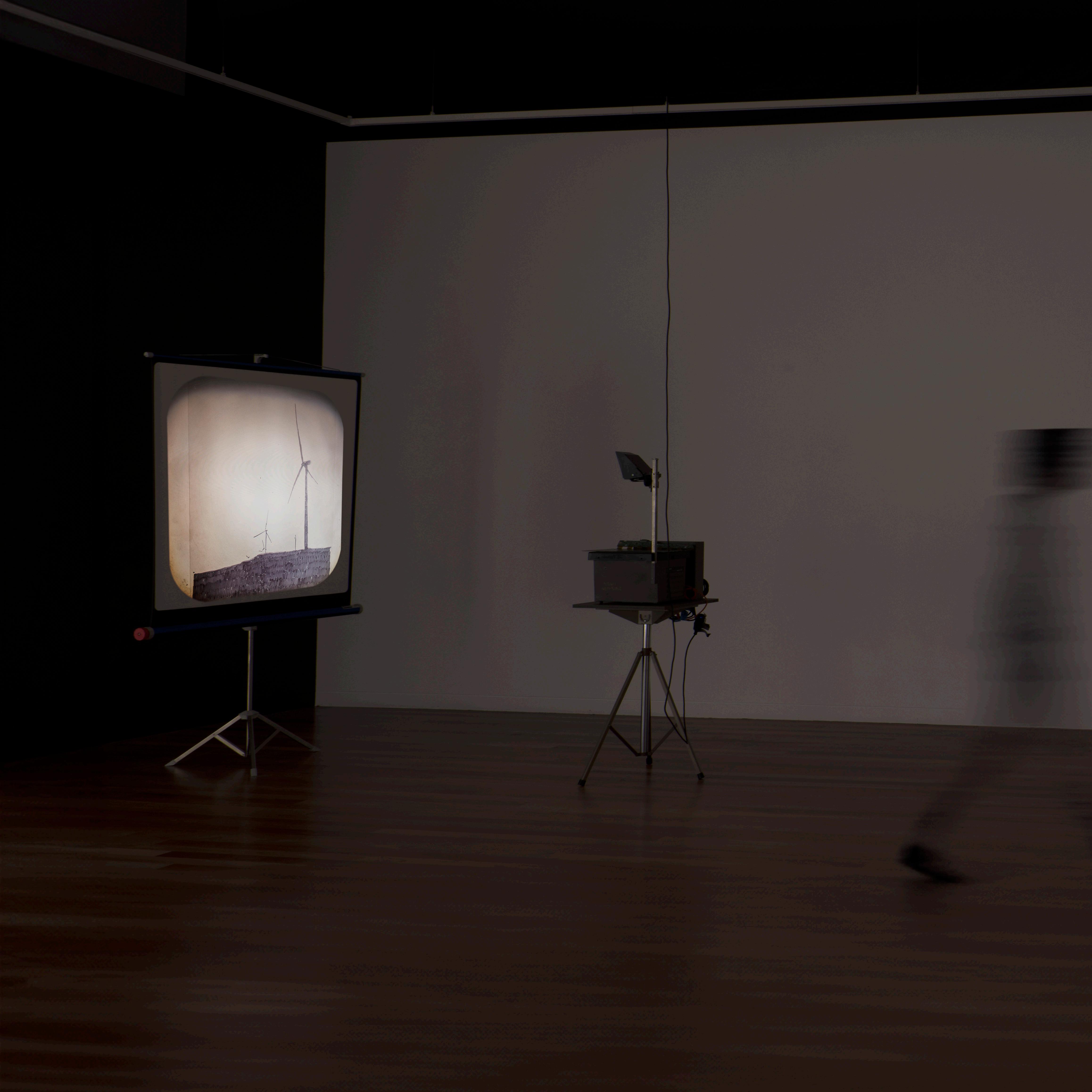 Left WENDY DAWES
Perpetual Motion Machine, 2023
Permanent marker on transparency film, overhead projector, deconstructed LCD monitor, screen, dimensions variable
Photograph by Brenton McGeachie
Left WENDY DAWES
Perpetual Motion Machine, 2023
Permanent marker on transparency film, overhead projector, deconstructed LCD monitor, screen, dimensions variable
Photograph by Brenton McGeachie
 Right BRIDGET BASKERVILLE
Dead River (detail), 2023
2 channel video, dimensions variable
Photograph by Brenton McGeachie
Right BRIDGET BASKERVILLE
Dead River (detail), 2023
2 channel video, dimensions variable
Photograph by Brenton McGeachie
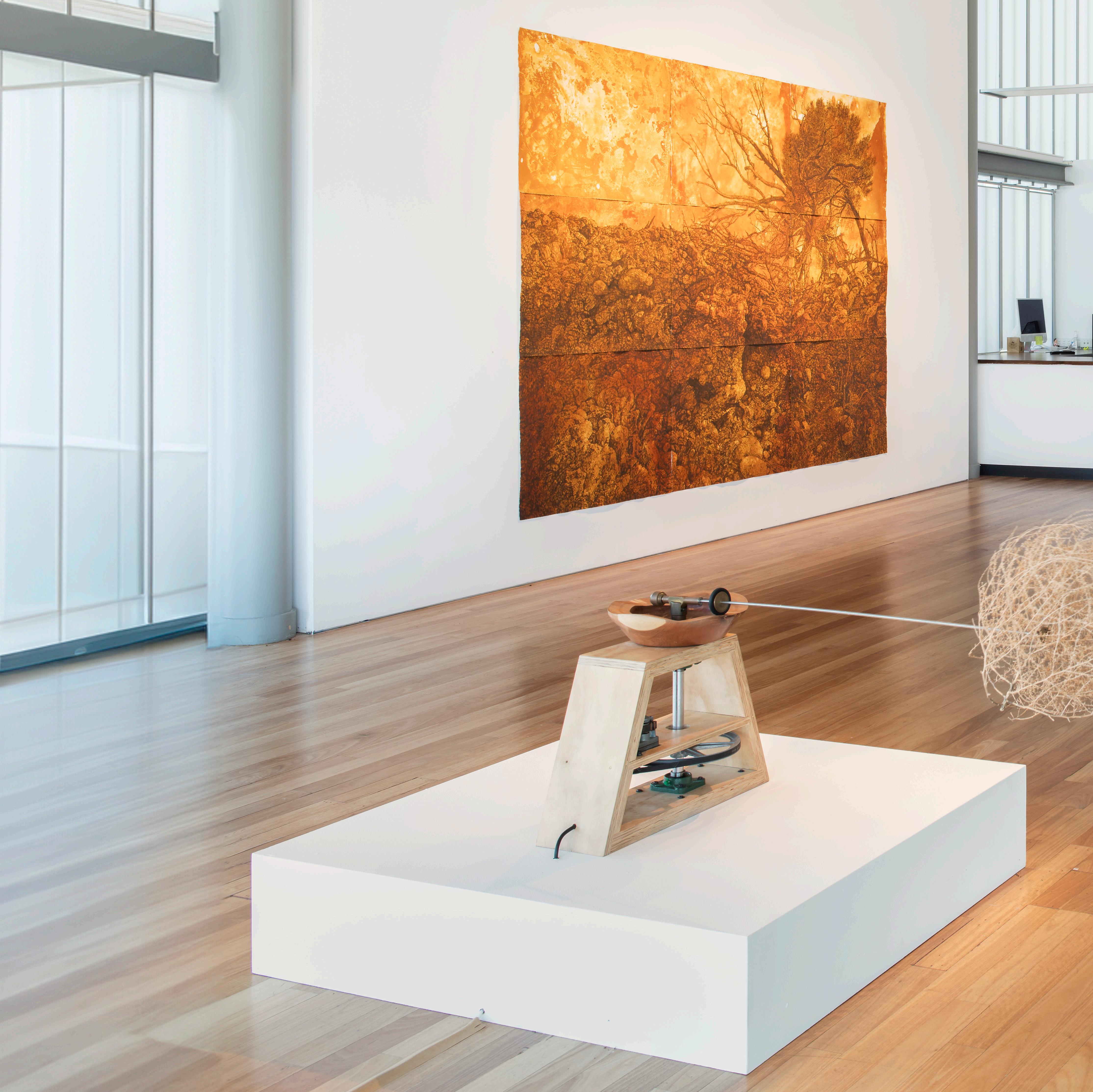
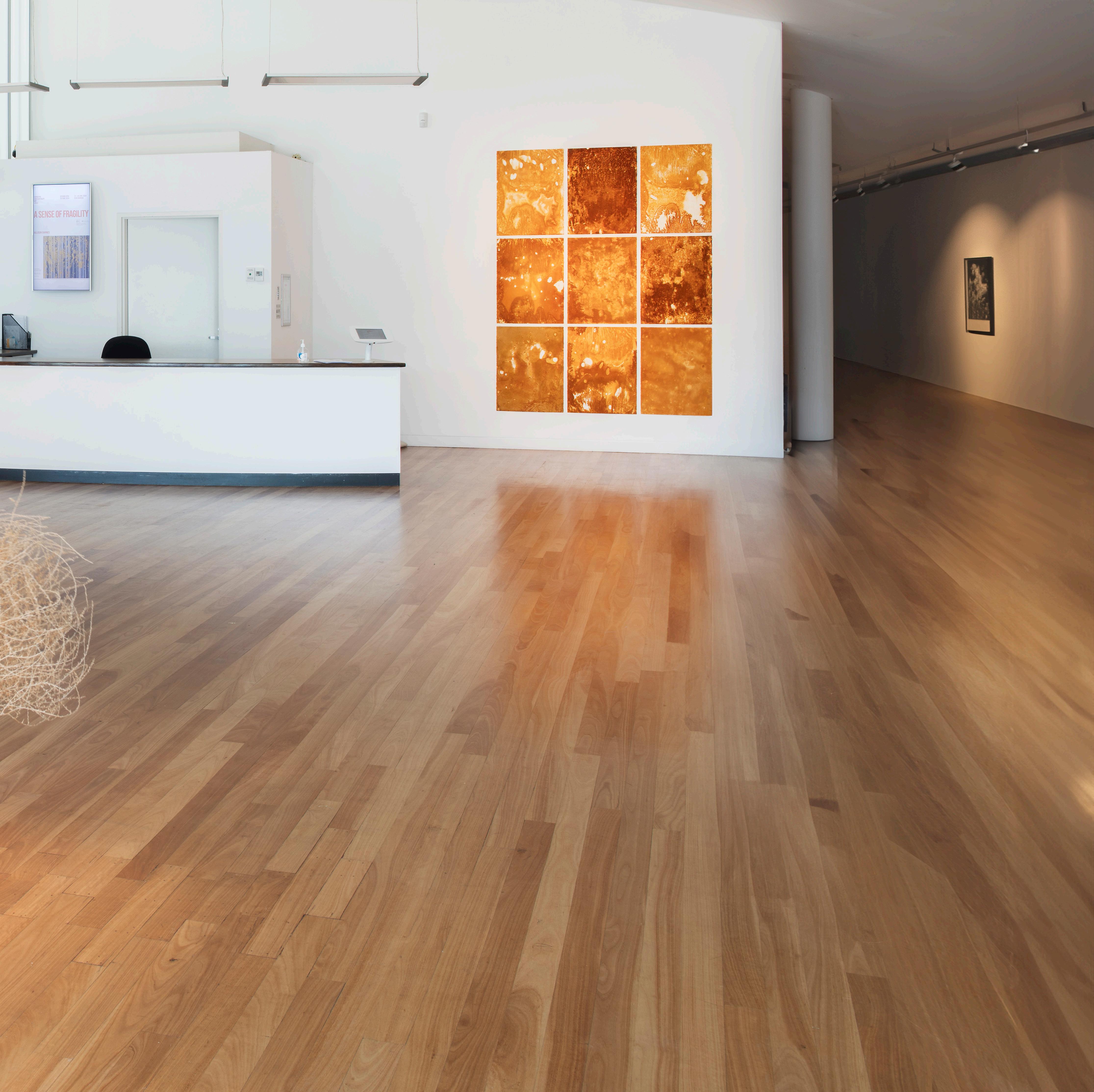 Left Above ANNIKA ROMEYN
Wana Karnu, 2024
Rust and ink on Rives BFK 300gsm paper, 240 x 360cm
Left Below MARLEY DAWSON
Untitled (tumbleweed again), 2013
Tumbleweed, stainless steel, brass, electronics, mechanics, MDF, timber 140 x 140 x 51cm
Above ANNIKA ROMEYN Reaction (detail), 2024
Rust on Rives BFK 250gsm paper 233 x 174cm
Photograph by Brenton McGeachie
Left Above ANNIKA ROMEYN
Wana Karnu, 2024
Rust and ink on Rives BFK 300gsm paper, 240 x 360cm
Left Below MARLEY DAWSON
Untitled (tumbleweed again), 2013
Tumbleweed, stainless steel, brass, electronics, mechanics, MDF, timber 140 x 140 x 51cm
Above ANNIKA ROMEYN Reaction (detail), 2024
Rust on Rives BFK 250gsm paper 233 x 174cm
Photograph by Brenton McGeachie
10
CCAS

BASKERVILLE
COPE WENDY DAWES
DAWSON SAMMY HAWKER
ROMEYN CURATED BY ALEXANDER BOYNES CANBERRA CONTEMPORARY ART SPACE
WITH NATURE BRIDGET
MEGAN
MARLEY
ANNIKA
Lakeside
Queen Elizabeth Tce
ACT
11am–5pm Tuesday to Saturday www.ccas.com.au Supported by CCAS acknowledges the Ngunnawal and Ngambri peoples, the Traditional Custodians of the Kamberri/Canberra region, and recognises their continuous connection to culture, community, and Country.
44
Parkes
2601 Open
February 20246 April 2024
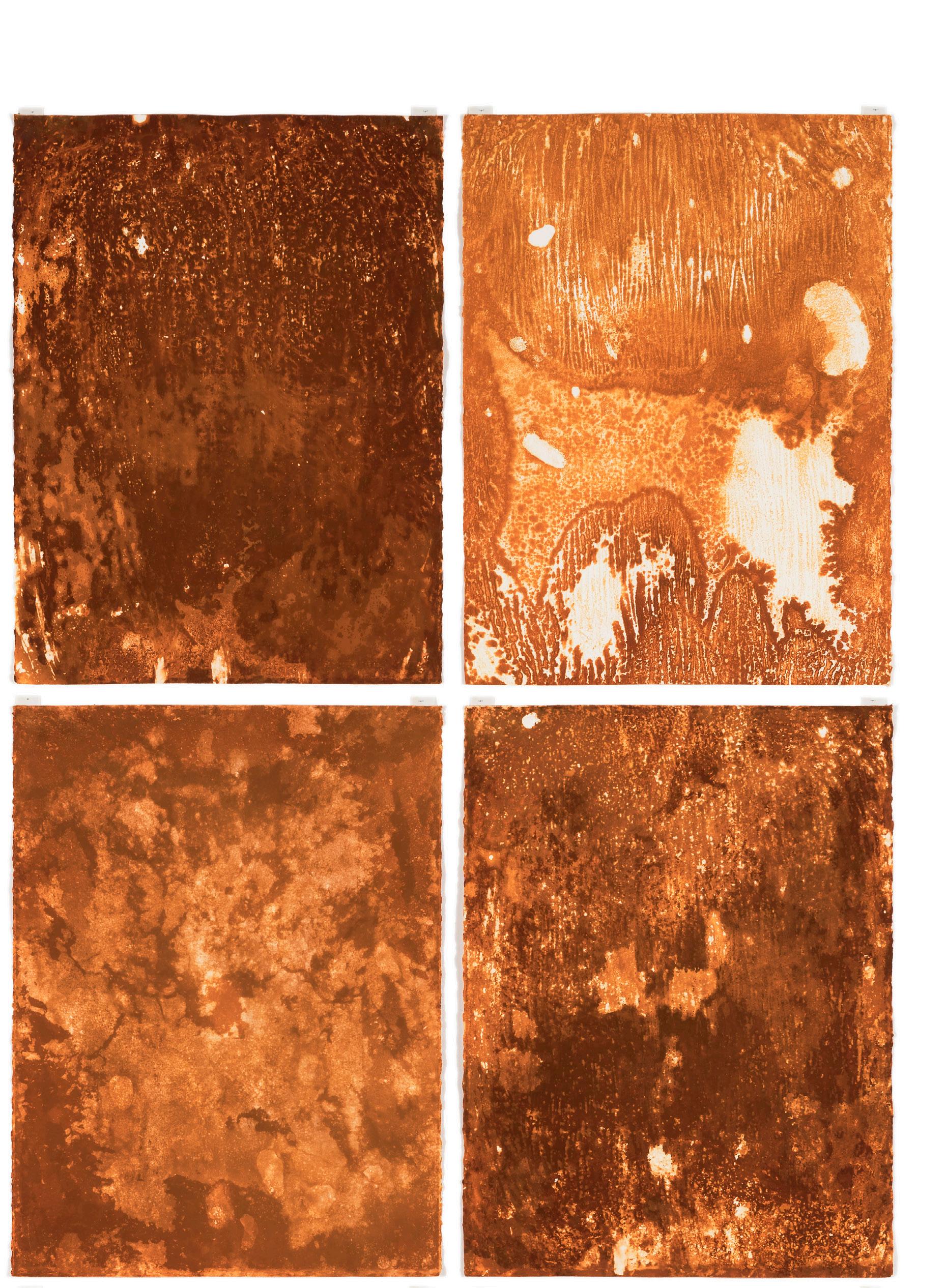

 Image BRIDGET BASKERVILLE
Dead River (detail), 2023, Corroded copper plates (10 x 25cm each)
Photograph by Brenton McGeachie
Image BRIDGET BASKERVILLE
Dead River (detail), 2023, Corroded copper plates (10 x 25cm each)
Photograph by Brenton McGeachie
 Image MEGAN COPE
Kinyingarra Guwinyanba (On Country) (video still), 2022
Single channel video, 6:36 duration
Videography by Cian Saunders
Image MEGAN COPE
Kinyingarra Guwinyanba (On Country) (video still), 2022
Single channel video, 6:36 duration
Videography by Cian Saunders

 Image ANNIKA ROMEYN
Wana Karnu, 2024
Rust and ink on Rives BFK 300gsm paper, 240 x 360cm
Photo by Brenton McGeachie
Image ANNIKA ROMEYN
Wana Karnu, 2024
Rust and ink on Rives BFK 300gsm paper, 240 x 360cm
Photo by Brenton McGeachie
 Left to Right SAMMY HAWKER
Salt Marks II, 2021-2023
Pigment ink-jet print, 60 x 84 cm, edition 1 of 10 +AP
Dark Crystals, 2021
Pigment ink-jet print, 110 x 138 cm, edition 2 of 5 + 2AP Wana Karnu, 2024
Photo by Brenton McGeachie
Left to Right SAMMY HAWKER
Salt Marks II, 2021-2023
Pigment ink-jet print, 60 x 84 cm, edition 1 of 10 +AP
Dark Crystals, 2021
Pigment ink-jet print, 110 x 138 cm, edition 2 of 5 + 2AP Wana Karnu, 2024
Photo by Brenton McGeachie
 Left to Right SAMMY HAWKER
Mount Gulaga, 2021
Pigment ink-jet print, 110 x 138 cm, edition 3 of 5 + 2AP
Salt Marks I, 2021-2023
Pigment ink-jet print, 60 x 84 cm, edition 1 of 10 +AP
Photo by Brenton McGeachie
Left to Right SAMMY HAWKER
Mount Gulaga, 2021
Pigment ink-jet print, 110 x 138 cm, edition 3 of 5 + 2AP
Salt Marks I, 2021-2023
Pigment ink-jet print, 60 x 84 cm, edition 1 of 10 +AP
Photo by Brenton McGeachie
 Left BRIDGET BASKERVILLE
Dead River, 2023
Corroded copper plates (10 x 25cm each), 2 channel video, dimensions variable
Photograph by Brenton McGeachie
Left BRIDGET BASKERVILLE
Dead River, 2023
Corroded copper plates (10 x 25cm each), 2 channel video, dimensions variable
Photograph by Brenton McGeachie
 Right MARLEY DAWSON
Hum (Louis + Morris), 2022
Brass, steel, timber, electronics, 184 x 71 x 6cm each
Photograph by Brenton McGeachie
Right MARLEY DAWSON
Hum (Louis + Morris), 2022
Brass, steel, timber, electronics, 184 x 71 x 6cm each
Photograph by Brenton McGeachie
 Left SAMMY HAWKER
Photo by Brenton McGeachie
Left SAMMY HAWKER
Photo by Brenton McGeachie
 Above MEGAN COPE
Kinyingarra Guwinyanba (On Country), 2022
Single channel video, 6:36 duration, videography by Cian Saunders
Right MEGAN COPE
Untitled (Extractions II), 2020
Concrete, pacific oyster shells, abalone shell, dimensions variable
Photo by Brenton McGeachie
Above MEGAN COPE
Kinyingarra Guwinyanba (On Country), 2022
Single channel video, 6:36 duration, videography by Cian Saunders
Right MEGAN COPE
Untitled (Extractions II), 2020
Concrete, pacific oyster shells, abalone shell, dimensions variable
Photo by Brenton McGeachie
 Left WENDY DAWES
Perpetual Motion Machine, 2023
Permanent marker on transparency film, overhead projector, deconstructed LCD monitor, screen, dimensions variable
Photograph by Brenton McGeachie
Left WENDY DAWES
Perpetual Motion Machine, 2023
Permanent marker on transparency film, overhead projector, deconstructed LCD monitor, screen, dimensions variable
Photograph by Brenton McGeachie
 Right BRIDGET BASKERVILLE
Dead River (detail), 2023
2 channel video, dimensions variable
Photograph by Brenton McGeachie
Right BRIDGET BASKERVILLE
Dead River (detail), 2023
2 channel video, dimensions variable
Photograph by Brenton McGeachie

 Left Above ANNIKA ROMEYN
Wana Karnu, 2024
Rust and ink on Rives BFK 300gsm paper, 240 x 360cm
Left Below MARLEY DAWSON
Untitled (tumbleweed again), 2013
Tumbleweed, stainless steel, brass, electronics, mechanics, MDF, timber 140 x 140 x 51cm
Above ANNIKA ROMEYN Reaction (detail), 2024
Rust on Rives BFK 250gsm paper 233 x 174cm
Photograph by Brenton McGeachie
Left Above ANNIKA ROMEYN
Wana Karnu, 2024
Rust and ink on Rives BFK 300gsm paper, 240 x 360cm
Left Below MARLEY DAWSON
Untitled (tumbleweed again), 2013
Tumbleweed, stainless steel, brass, electronics, mechanics, MDF, timber 140 x 140 x 51cm
Above ANNIKA ROMEYN Reaction (detail), 2024
Rust on Rives BFK 250gsm paper 233 x 174cm
Photograph by Brenton McGeachie
